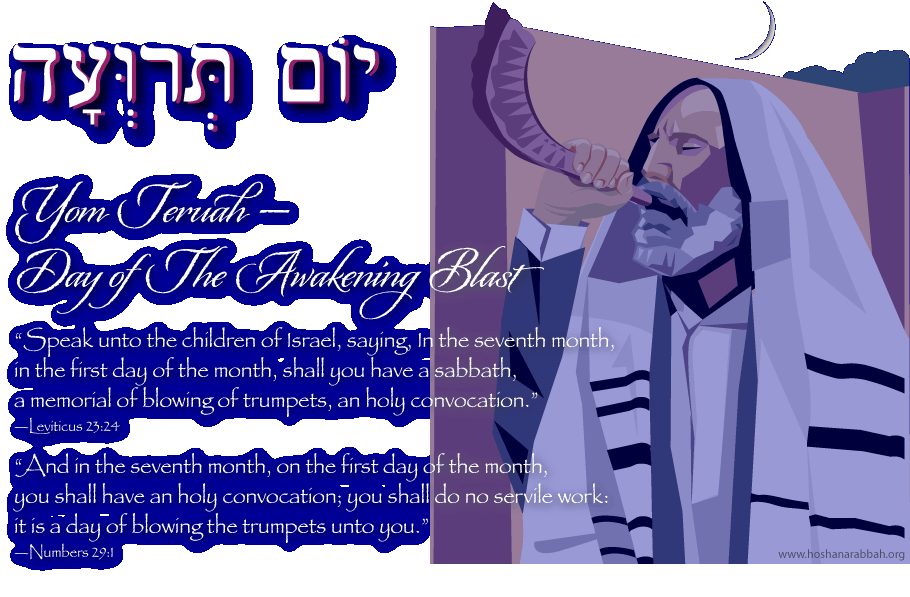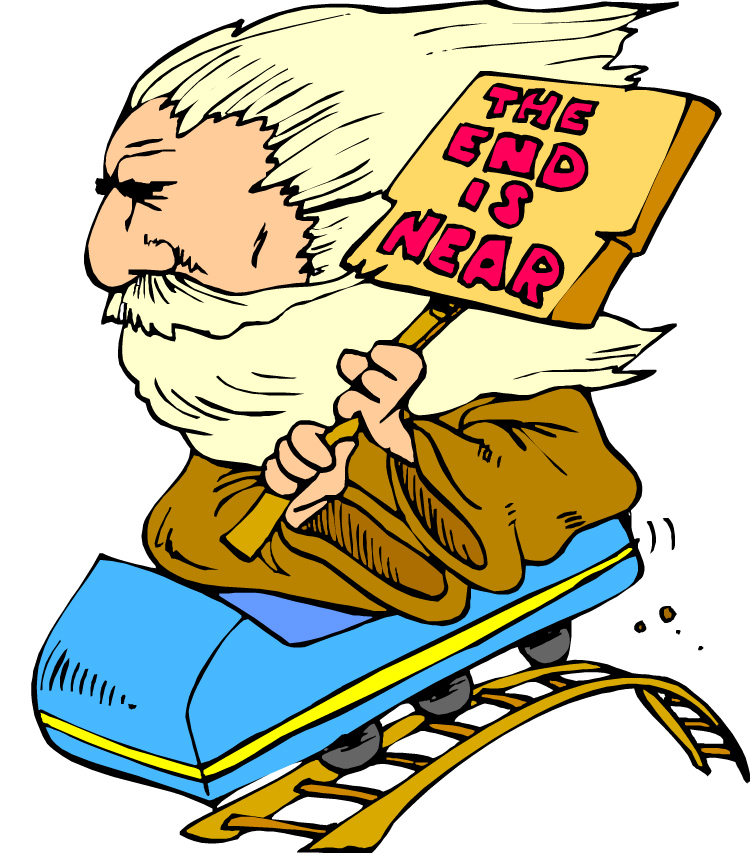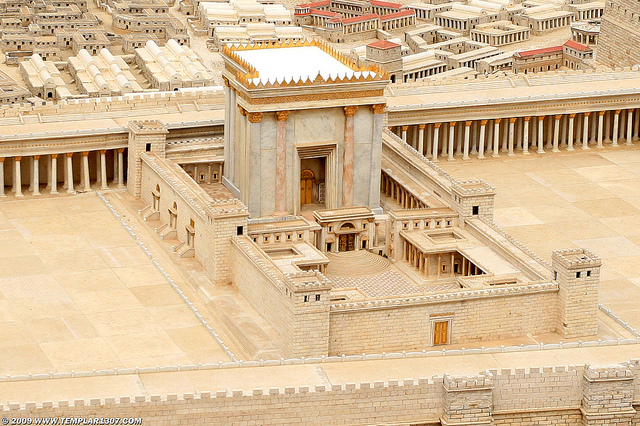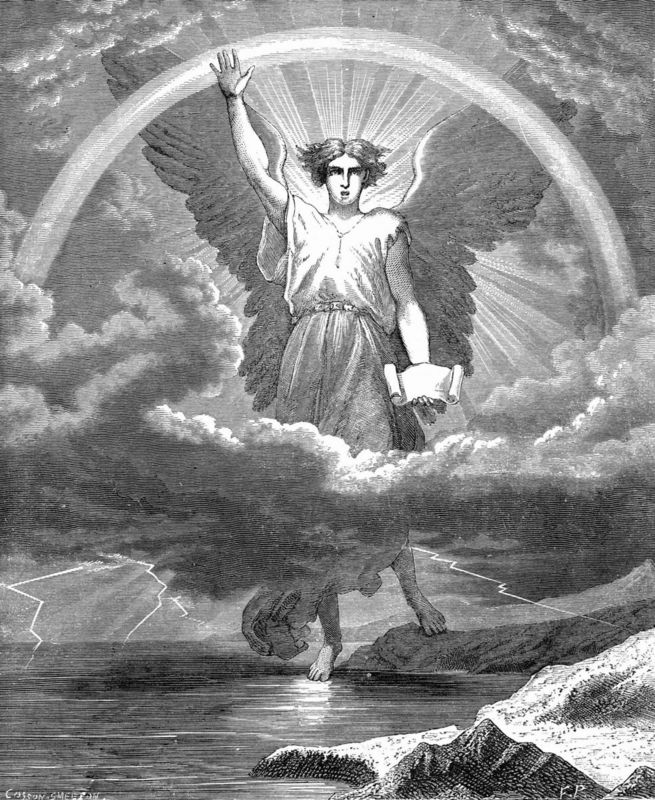Tag Archives: Matthew 24
UPDATED: Yom Teruah—The Historical Roots of Our Faith, Present Relevance for Believers & Prophetic End-Time Implications

By Ya’acov Natan Lawrence
Hoshana Rabbah Biblical Resources
This will be one of the most comprehensive articles you have ever read on this subject and contains revelation you will read nowhere else. Hopefully it will help to light your spiritual fires!— Nathan
Arise thou that sleepest, and arise from the dead, and Messiah shall give thee light. (Eph 5:14, also 8–16)
Yom Teruah—The Beginning of the Fall (End-Time) Harvest
Yom Tom Teruah or the Day of Trumpets, Shouting or Shofar Blasts (commonly called “Rosh Hashana”) occurs at the end of the summer months and marked the beginning of the fall harvest or festival season for the ancient Israelites. But this biblical holiday is much more than a time to harvest the late summer and early fall fruits and vegetables from your garden or orchard. Rather, it is a time of the harvest of souls for the kingdom of heaven! Read on and discover how and when this will occur and how you can be part of this glorious event.
In the Creator’s larger plan of salvation for humankind, Yom Teruah is the fourth of seven of YHVH Elohim’s biblical holidays or holy days (colloquially referred to as “feasts”), where the Creator lays out his progressive plan of redemption or salvation. It all starts with Passover in the spring which symbolically and prophetically pictures a new believer coming to faith in Yeshua the Messiah and culminates with the Eighth Day which pictures the now glorified saint-bride of Yeshua living forever in the New Jerusalem in the spiritual dimension of the new heavens on the new earth. So how does the Day of Trumpets figure into this seven-step scenario? As we shall see below, like a puzzle piece, Yom Teruah fits perfectly into the larger panoramic, multidimensional picture of heaven’s plan to create a family of glorified and immortalized humans who will live in a heavenly paradise with their Maker forever. So buckle your seatbelts for a glorious preview of what is to come if you are an ardent follower and lover of Yeshua the Messiah and his word!
Before probing the profound spiritual and prophetic implications of Yom Teruah, consider this. For many believers, the biblical feasts are merely a quaint, interesting if not intriguing ancient biblical ritual worth studying about, but that’s where it ends. This, however, was not the Creator’s intention in his Word. No! He commanded his people to keep, and yes, to celebrate his holy days by stopping one’s daily routine and dedicating an entire set-apart time period to their observance. To be sure, YHVH’s biblical feasts are more than a head trip for Jewish wannabes. Indeed, YHVH intended his people annually, literally and experientially to walk through the seven steps of his glorious plan of salvation. Why? There are many reasons for this that we will discuss in more detail below, but their are several main reasons. Most notably, these steps are a way to transmit to our child key biblical truths relating to their eternal destiny with the hope that they will remain faithful to YHVH all the days of their lives. The feasts also serve to remind the saints about their past history, their present spiritual condition and what lies ahead for them in the future if they remain faithful to YHVH and his Word. Now consider this. Humans typically commemoratively celebrate past notable events in their lives annually such as birthdays, anniversaries, or national holidays. Notice the emphasis on the word past? This is because it is impossible for humans to commemorate future events, since no one can accurately predict the exact timing of any future event. Right? This is not the case with the Creator’s biblical feasts. They are unique in all of human experiences and men’s traditions in that they not only commemorate past historical events, but also present realities or expectations in the believer’s life, as well as, and note this well, future events that have yet to occur. Only YHVH can predict the future, and the fall feasts, at least, allow us mortals to peer into the future to see what the Creator has in store for the human race and, more specifically, the saints who have put their trusting faith in him.
So now let’s unpack the major ramifications of YHVH’s biblical feasts and then zoom in specifically on Yom Teruah to explore the depths and riches of this step in the Creator’s plan of salvation.
Prophetically, the summer months between the Feast of Weeks or Pentecost (in Hebrew Chag haShavuot) in the late spring and the autumn feast of Yom Teruah is a spiritual picture of what is often called the “Church Age,” which is the period of time from the Feast of Pentecost in Acts chapter two until the return of Yeshua the Messiah at the end of the age and lasting for approximately 2000 years. For many people, especially those living in hotter climes, summer is a time of leisure, vacation, weariness and fatigue due to the excessive heat. Likewise, many Bible believers have fallen asleep growing spiritually weary while waiting for the return of the Messiah. Yeshua discusses this issue in the Parable of the Ten Virgins (Matt 25) who all grew weary and fell asleep awaiting the coming of the Bridegroom (Yeshua).
This all changes on the first day of the seventh month of the biblical Hebrew calendar when off in the distance the sound of a shofar blast suddenly pierces the atmosphere and registers in the eardrums of those who have fallen asleep. Not only does this shofar blast signal the beginning of the seventh month when the new crescent moon is sighted, but it announces the return of the Bridegroom (Yeshua) coming for his bride (the virgin saints). As in the Parable of the Ten Virgins, the cry went forth that the bridegroom was coming and all awoke from their slumber to prepare for his arrival. In these end days, that cry is going forth even now for all to hear, to awake and to prepare for the arrival of Yeshua the Messiah.
In the biblical calendar, the visible sighting of the crescent new moon always marks the beginning of the month and is announced by the shofar blast (Ps 81:3). Likewise, on the first day of the seventh month of the biblical calendar, the arrival of the new moon (called Rosh Chodesh) when the shofar sounds marks the beginning of Yom Teruah. This is the first day of the fall (festival) harvest season and is the time when the call goes out for the spiritual drowsy to awake, and to hear the voice of YHVH, to be invigorated by the breath or voice of the shofar, which is symbolic of YHVH’s prophetic word or oracle going forth across the earth in the last days.
Furthermore, the ram’s horn shofar is bent into a curved shape to represent the contrite heart of both the blower and the hearer. This is the season for the righteous to bend their hearts in humility and contrition before YHVH and repent of spiritual lassitude and lukewarmness and to awake to spiritual action and preparation, for the fall feasts point to awesome end time events that will occur at some point in time in the near future. It is a time to be refreshed by the breath of YHVH, and a time of new beginnings. Let YHVH breathe on you, revive you and empower you as you enter into the fall biblical festival season, and as you prepare to meet your King and Redeemer, Yeshua, in the air.
Yom Teruah also begins a season that prophetically speaks of war and battle, for in ancient times the shofar was a weapon of warfare in Israel, and it will be used again as such in the end times. It was used to call Israel to battle, to defeat her enemies with the help of YHVH. The shofar was then used to proclaim victory after the battle was won and to worship YHVH who had given them the victory. The battle against Israel’s enemies still rages on—even in the end times. Today, the enemies of the redeemed Israelites are mostly spiritual. They are the world, the flesh and the devil (Jas 3:15; Eph 2:2–3). Through faith in Yeshua the Messiah who defeated death, hell and the grave, we can have victory over mortality, sin, the devil and this world (1 Cor 15:51–57; Rom 8:27; 1 John 4:4; 5:4; Rev 12:11). As we hear the sound of the shofar calling us to arise from spiritual slumber, YHVH is telling his people to become overcomers, so that they may be worthy to partake of the glories of his eternal kingdom (Rev 2:7, 11, 17, 26; 3:5, 12, 21).
Yom Teruah is also the time of the reaping of the summer harvest. Spiritually speaking, this period will be the time of the reaping of the righteous to their reward (Rev 14:4) and the harvest of the wicked to the great winepress of Elohim’s wrath (Rev 14:14–20). It is the time of the resurrection of the dead in Messiah Yeshua at the end of the tribulation (Matt 24:29) and the beginning of Elohim’s wrath being poured out upon the nations (see Joel 3:11–13). This begins the wrath of Elohim time pictured by Yom Kippur (the Day of Atonement, which occurs ten days after Yom Teruah) before which time the dead saints will have been resurrected and given their spiritual, glorified, second Adam bodies.
The New Moon (Rosh Chodesh) and Yom Teruah—A Day of New Beginnings and Expectancy
In anticipation of Rosh Chodesh (the new moon sighted each month) and hence the beginning of Yom Teruah, there is a sense of expectancy and excitement among the saints. It is a time of watching and praying, for the renewal of the moon (the word new as in new moon [Col 2:16] in the Greek New Testament is kainen meaning “renewal or restoration of something which already exists”and is not the word neos which means “brand new”), which represents “new beginnings, good tidings, the renewal of the individual as well as the community.”
The sixth month on the biblical calendar is traditionally referred to by its non-biblical Aramaic name Elul. Some rabbinical sources see this word as an acronym of “Ani l’dodi v’dodi li,” “I am my Beloved’s and my Beloved is mine,” a quote from Song of Songs 6:3, where the Beloved is YHVH and the “I” are YHVH’s people. In Aramaic (the vernacular of the Jewish people at the time that the month names were adopted), the word Elul means “search,” which is appropriate, because this is a time of year when we search our hearts. (from the web site: http://www.jewfaq.org/elul.htm#Selichot).
During the month of Elul, our focus is to be on repentance, restoration and preparation for the coming of the Messiah. In order to repent one must understand that Scripture defines sins as the violation of YHVH’s Torah, or instructions or teachings in righteousness (1 John 3:4). Sin or chet in Hebrew, in a loose sense, means “a failure in our relationship with Elohim.” Our goal should be to continually move closer to Elohim, but “chet” is behavior that causes us to move away from Elohim.
If YHVH requires his people to turn away from sin and turn to righteousness (the act of which is called repentance), then what is therefore involved in repentance? Repentance or teshuvah in Hebrew, means “to return.” In the biblical context, it means “to return to Elohim” and to behavior required of us by Elohim; in other words, return to obedience to his commandments. While we deeply regret our movement away from Elohim, we must not despair, for YHVH has provided the way for our return to him and he tells us that when we repent, he forgives without delay.
According to Scripture, there are, several basic steps to repentance:
- We must first recognize that we have a problem — that we are sinful to the core (Jer 17:9; Rom 8:7; Rom 3:10–18, 23; Isa 64:6). For this to happen, we have to come to grips with the fact that we have broken Elohim’s laws, which define sin (1 John 3:4). Human pride makes this step the hardest one to take.
- We must confess our sin before YHVH (Lev 5:5; Num 5:7).
- We must turn from our sins and resolve to stop sinning.
- We must manifest heartfelt regret for our wrong actions by evidencing remorse and contrition before YHVH and our fellow man, if applicable.
- An offering of the legally prescribed sacrifice must be made for the sin (Lev 5:1–20). Yeshua, the Messiah of Israel, became that sacrifice for our sin once and for all when he died on the cross (Isa 53:5; Heb 4:14–5:10; 7:14–8:6; 9:11–10:22).
- When we have sinned against our fellow man, not only is confession and forsaking that sin required, but we must make restitution in full of whatever has been wrongfully obtained or withheld from one’s fellow man (Lev 5:14–19; Matt 5:23–25).
- We must then accept our Heavenly Father’s unconditional mercy and grace (Ps 103:3–4, 10–17).
The shofar’s blowing is a call to awaken out of spiritual sleep, lethargy, stagnation, slumber and to repent of sin. No man knows the day or the hour of the new moon’s arrival each month (though one who is alert certainly can know the season and year), so the human tendency is to grow weary in waiting, and to grow slack in one’s obedience to YHVH’s righteous commands. Yet when the new moon is sighted and the shofar sounds, this is the signal for the slumbering to awake, for hope to arise, renewal and spiritual revival to occur and action to be taken to put off sin and to draw closer spiritually to YHVH Elohim.
The awakening sound of the shofar blast is the Hebrew word teruah (see Lev 23:24 and Num 29:1 where the phrase “blowing of trumpets” is teruah), which means “the shout or blast of war, alarm, alarm of war, war cry, signal, and sound of tempest.” Teruah derives from the Hebrew root word ruah meaning “alarm, signal, sound or blast of the shofar, to raise a shout.” The name Yom Teruah could therefore have several literal meanings: “the day of the shout, the day of the war alarm or the day of the shofar blast.”
When we understand the significance of this day from a biblical understanding, we realize that Yom Teruah is a day of shouting (with exultant joy or as a shriek in alarm), or a day of shofar blowing. Shofars were blown in biblical times to rally the people together, to alert the people in time of war, to warn the people, or as an instrument (along with shouts) to express the people’s joy, or to praise YHVH.
As we shall see, Yom Teruah prophetically involves all these concepts, for it is a day when YHVH’s people will shout with joy as they gather to meet Yeshua in the air after having been bodily resurrected at the sound of the last shofar blast, but it is also a time of alarm and shrieking on the part of the wicked as a time of war and terror brought on by the judgments of YHVH are about to come upon the earth.
Additionally, Yom Teruah is a day of new beginnings or renewal, to wake up from lethargy and slumber, to be broken out of that sleepy, comfort zone state and to be awakened to action. Again, remember the ten virgins of Matthew 25 who slept in anticipation of the bridegroom’s arrival? When the shout went forth that he was coming they were all awakened. Some were prepared to go into the marriage supper of the bridegroom and some were not. Our Bridegroom is Yeshua.
Yom Teruah Versus Rosh Hashana
Nowhere in Scripture is this festival referred to as Rosh Hashana, which literally means “head of the year”—a reference to the extra-biblical Jewish tradition that the first day of the seventh month is the beginning of the new year. Scripture is very clear about when the biblical new year begins. In Exodus 12:2, YHVH instructs the children of Israel that the month of the abiv barley grain would be the beginning of the year for them. Fourteen days after the beginning of this month the Passover occurs. The beginning of the biblical year is in the early spring of the year when plant life is bursting forth from a long dead winter season. It is a picture of spiritual rebirth or redemption for YHVH’s people.
It is true that the Jewish sages recognize Abib (or Aviv) or Nisan in the spring as the first month of the biblical calendar and the beginning of civil or agricultural year for ancient Israel, now Judaism recognizes the first day of the seventh month (called Yom Teruah in the Bible or Rosh Hashana in modern Jewish tradition) as the beginning of the civil and religious year (Exploring Jewish Tradition, by Rabbi Abraham Witty, p. 120; The Jewish Book of Why, by Alfred Kolatch, pp. 222–223). In fact, the rabbinic Jews maintain the tradition that there are four new years (Kolatch, p. 223; Talmud Rosh Hashana 1:1):
- The first of Nisan/Abib for royalty (dating of royal events).
- The first of Tishiri for agriculture (the beginning of the harvest season) and traditionally commemorating the creation.
- The first of Elul for tithing cattle.
- The first of Shevat as the new year for trees.
Additionally, one Jewish scholar believes that the rabbinic tradition that Rosh Hashana is the beginning of the new year actually derives from pagan customs absorbed by the Jewish people while living in Babylon. These ancient pagans had a new year’s festival called Akitu, that happened to fall on the same day as Yom Teurah. Gradually, the Jews assimilated Yom Teruah with Akitu with the result being Rosh Hashana. (For more information on this, go to http://www.karaite-korner.org/yom_teruah.shtml#sdfootnote1sym.)
With all due respect to our Jewish brothers, we choose to follow a more literal and strict biblical determination for when the new year is to start and what the name of the festival of the first day of the seventh month is to be. Furthermore, we choose not to follow traditions that are mixed with or derived from pagan practices. Therefore, we neither recognize Rosh Hashana as the true biblical name for this festival, nor as the beginning of the biblical new year.
Overview of the Biblical Feasts
Before continuing our study on Yom Teruah, the fourth of the seven of YHVH’s annual set-apart festivals when he meets with his people, let us quickly review the other six divine appointments. Without understanding Yom Teruah’s synchronization as it relates to the other feasts and YHVH’s overall plan of redemption as revealed in the seven annual feasts, one cannot fully appreciate this fourth festival.
If you had to sum up the entire message of the Bible in one word what would it be? Probably words such as love, hope, salvation, eternal life or heaven are coming to your mind. But I challenge you to find a better word than the following: r-e-c-o-n-c-i-l-i-a-t-i-o-n. The dictionary defines reconciliation as “to restore to friendship or harmony, to settle or resolve a quarrel, to make consistent or congruous.” When man chose to rebel against YHVH and to give in to sin at the Tree of the Knowledge of Good and Evil at the very beginning he chose the path of separation from his Heavenly Father. Sin causes man to be separated from a totally holy, righteous and sinless Creator. Since that time YHVH has been endeavoring to reconcile man to himself. He has laid out criteria for man to follow for this to occur—for man to once again have a friendly, loving and intimate relationship with his Heavenly Father as did Adam before he sinned.
Continue readingNatan’s Notes on Matthew 24—Where are we at in end times biblical prophecy?

Today, Shabbat, I have been busy studying and writing in preparation for Yom Teruah—the Day of Shouting or Shofar Blasts. In several days (Thursday, Sept. 9 on the biblical crescent new moon, abib barley calendar), my family and I will be celebrating this first of four fall biblical feasts, which our rabbinic Jewish brothers incorrectly refer to as Rosh Hashanah—an unbiblical name. Although Scripture gives us but scant information about this high holy day, its significance relative to the disciple of Yeshua’s cannot be overestimated.
In light of the current global chaos occurring on so many fronts and the tidal wave of evil that is systematically sweeping across the earth, Yom Teruah affords the faithful saint a great opportunity to celebrate in advance a glorious upcoming event. This is because Yom Teruah not only points prophetically to the second coming of Yeshua the Messiah but to the resurrection and glorification of his righteous saints as well. (See my in-depth study article on the subject at https://www.hoshanarabbah.org/pdfs/yom_teruah.pdf)
In preparation for celebrating this biblical holiday, I have put together a study on Matthew 24, the famous Olivet Discourse, where Yeshua talks about end time events as they will occur in more or less chronological order. This is an excellent place to attempt to figure to where we are at in the progression of events that signify the end of the age or end times just before the second coming of Yeshua the Messiah.

What follows is my best analysis of the subject based on decades of Bible study. However, I reserve the right to be wrong on anything that I write below. Regardless of biblical understanding, we are still looking through a glass darkly, and we will not fully understand end time events until they are occurring or have already occurred. This is a biblical provable fact regardless of what the profit motive driven Christian prophecy pundits and prognosticators will tell you.
So here is my best analysis on the first part of Matthew 24.
Matthew 24

Matthew 24:1–51, The Olivet Prophecy and the Book of Revelation. See notes in Revelation entitled “Revelation and the Olivet Prophecy (i.e. Matt 24 and 25) Compared.”
Matthew 24:1, The buildings of the temple.The geographical context of Yeshua’s Olivet Discourse contained in Matthew chapters 24 and 25 is the Temple Mount containing Herod’s Temple (vv. 1–2), and from the vantage point of the Mount of Olives overlooking the same (v. 3ff).

Matthew 24:3, Do you see? Yeshua’s predicts the destruction of the temple—a prophecy that was clearly fulfilled in A.D. 70.
Matthew 24:3, Tell us. Yeshua’s statement as to the destruction of the temple elicits further questions from his disciples. Yeshua’s following discourse is in response to three questions that his disciples asked him, while on the Mount of Olives overlooking the Temple Mount. These three questions were:
- When shall these thing be?
- What shall be the sign of your coming…
- And the [sign of] end of the age?
The first question is in response to Yeshua’s statement that the temple would be destroyed. The temple was destroyed approximately forty years later in A.D. 70.
The second questions is more open-ended as to the timing of its fulfillment. The disciples knew that Yeshua would eventually return as the Conquering King, Son of David Messiah, even as so many Old Testaments prophets had predicted and of which the disciples were well aware. The disciples had no way of knowing whether Yeshua’s second coming was imminent or far away timewise.
The third question refers to the end of this present age age when Messiah will establish is kingdom on earth—a subject that many Old Testament prophets had written about. We now refer to this Messianic Age as the Millennium based on John’s book of Revelation. There we learn that at the end of this present age, Yeshua will return from heaven to destroy the world-ruling kingdom of Satan (called Mystery Babylon the Great) along with all of his demonic and human minions, and will then establish his kingdom on this earth for one thousand years.
So as we can see, the three questions that Yeshua’s disciples asked and that he subsequently answered cover a long time span including from the destruction of the temple in A.D. 70 until the end of the age some two thousand years later.
Therefore, the Olivet Prophecy must be viewed as being fulfilled over a long, protracted time-frame. This view, however, has not been that of many classical Christian scholars, who, rather, have viewed Yeshua’s prophecy as having been fulfilled in A.D. 70 and subsequently thereafter with the establishment of the Roman Catholic Church as Yeshua’s supposed kingdom on the earth. It is total folly to view the largely apostate, paganized Roman Catholic Church with all of its offshoot denominations as representing Yeshua’s millennial kingdom on earth for several reasons.

First, the Roman Catholic Church and its spiritual daughters have, to one degree or another, failed to walk in Yeshua’s Torah-truths that he came to bring to its fullest expression (Matt 5:17) and not to destroy (Matt 5:18), and which he commanded his disciples to obey (Matt 5:20; John 14:15, 21) and teach (Matt 28:20). Rather, the Catholic Church and her spiritual daughters have spurned much of his Torah.
Second, all of these churches, in spite of the good works they may done on this earth in the name of Jesus, have not fulfilled the Old Testament prophecies that speak of the universal rule of King Messiah on this earth in specific detail. It certainly cannot be said that the Roman Catholic Church has fulfilled these millennial prophecies.
Third, the book of Revelation speaks of many events that have yet to transpire and that must happen before the Millennium. Most notable of these is Yeshua’s return on a white horse with his saints and the overthrow of all of men’s governments, and the defeat and banishment of Satan and his minions into the abyss for one thousand years.
Matthew 24:4, Deceive [Gr. planao] you/lead you astray. Planao means “to lead astray via fraudulence and seduction.” The fact that Yeshua mentions this warning first emphasizes the importance he places on this point. The fact that Satan comes as an angel of light seeking to devour spiritually whomever he can is the first and foremost tactic of the enemy of which the saints must be aware. The moment Elohim reveals his Truth to humans, whether it was in the Garden of Eden to the first humans, or in the form of his Son as the Word of Elohim incarnate, the enemy has been there to counterfeit it and to lead and to lure humans astray. His tactics have not changed from then until now and on to the end of the age.

Matthew 24:5, I am the Messiah. In Gospels of Mark and Luke, this phrase simply reads, “I am” (Mark 13:6; Luke 21:6). This can possibly be viewed as a Hebraic allusion to the I AM of Exodus 3:14, to which Yeshua likened himself in John 8:58. Matthew’s account adds the title the Messiah to I am. The word Messiah is from the Hebrew word mashiach meaning “an anointed or consecrated one.” Here Yeshua is plainly telling us that after him, many deceivers will come claiming to be the one that heaven has anointed or consecrated as its divine messenger to humans. The world is full of pseudo-messiahs and those claiming to be Elohim’s messenger and billions of people have been deceived to follow many false religions. Mohammed, the founder of Islam is a leading example of false prophet or anointed one. There have been plenty of such individuals in the Christian church as well.
Continue readingThe Book of Revelation and the Olivet Prophecy (Matt 24 and 25) Compared

Not unlike treasure hunters examining a map for clues leading to a buried treasure, or an archeologist carefully scrutinizing ancient artifacts for information about lost civilizations, or an engineer diligently studying blueprints in order to construct a mechanical device or a building, we have briefly examined some of YHVH’s spiritual blueprints found in the Scriptures to give us clues about the nature and order of end-time events. Understanding the seven biblical feasts, the seven stations in the tabernacle of Moses and the various steps of the biblical wedding will help us to decode the mysteries surrounding the events pertaining to the second coming of our Master, Yeshua the Messiah.
Introducing the Olivet Prophecy
Now let us carefully investigate another set of spiritual blueprints: Yeshua’s prophecy in Matthew 24 and 25, commonly called the Olivet Prophecy.
Having a working knowledge of all these “blueprints” will help us to discover who we are as a people in the eyes of YHVH, where we have come from, where we are presently, and where we are going—that is, what the future holds for us, and what our spiritual destiny or divine inheritance is. Only then will we understand the end-time prophetic events leading up to the second coming of Yeshua, and we will learn what our role will be to play in them.
As we begin to examine Matthew 24 and 25, it is important first to note the chronological positioning of this prophecy in the context of the passages before and after this pivotal chapter. The chapters that precede Matthew 24 prophetically speak of precursory events leading up to the second coming of Yeshua, while those that follow Matthew 24 prophetically delineate events that occur after his return.
Matthew 24 sits like a diamond in the midst of a brilliant gold setting. It speaks of the order of end time events pertaining to the second coming of Yeshua the Messiah, our beloved King, Redeemer and Savior. Listed below is a chronology of events as Matthew lays them out, more or less, in the order in which they will occur prophetically. Many of these passages will be elucidated upon later in this book. It is important that we present the overall layout of end-time events here and now before studying the individual components in detail later.
Continue readingStanding Like a Rock in the End Times—Nineteen Tips to Surviving Evil’s Onslaught Against Us

In light of Yeshua’s last days warnings in his Matthew 24 discourse, what should we do? Below are some suggestions that will help you not to only survive, but to thrive in these end times as we await the second coming.
In these increasingly dark and evil days in which we are now living where evil is made to appear to be good, down is up and black is white, and where YHVH’s people are being increasingly marginalized, persecuted and even killed, what should we be doing in the face of evil’s onslaught against us? The following list provides some answers from the Scriptures.
- Watch and pray (Matt 26:41; Mark 13:33; 14:38; Luke 21:36).
- Pray that you might be counted worthy to escape YHVH’s judgments that will be coming on the earth because of wickedness (Luke 21:36).
- Endure to the end (Matt 24:13; Mark 13:13).
- Keep your eyes on Yeshua the Lamb and follow him wherever he goes (Rev 14:4).
- Occupy until Yeshua comes (Luke 19:13). Be busy doing what Yeshua has called you to do.
- Engage in intercessory prayer, though at this time, it may not do much good, since biblical prophecy has to be fulfilled as end time events occur. This means that things will be getting worse and worse until Yeshua returns and destroys Babylon the Great New World Order.
- Be an overcomer in every way possible. Be not be overcome by evil, but overcome evil with good (Rom 12:21). Those who overcome spiritual evil will experience great rewards (Rev 2:7, 11, 17, 26; 3:5, 12, 21)
- Be prepared to engage in civil disobedience as a last resort, if necessary. If civil laws violate YHVH’s laws, the Bible tells us to obey YHVH’s laws over men’s laws (Acts 4:19; 5:29; Ps 94:16).
- Be prepared to help persecuted brothers and sisters in any way possible. You might be next the next one to be persecuted!
- Continue to be salt and light to those around you in every way possible (Matt 5:13–16).
- Don’t expect things on earth to get better. Yeshua never said it would get better, but only darker before his return. He’s coming at the midnight hour when evil will be the most pervasive and rampant on the earth.
- Expect intense persecution of Bible believers (2 Tim 3:12; Matt 5:10–12; 10:22–25; 23:34; Mark 10:30; John 15:19–21; 16:2, 33; 17:14; 1 Thess 3:3–4; 1 Pet 4:12–16; Rev 7:14). Yeshua and the book of Revelation prophesy this will occur in the end times.
- Be wise as serpents (Matt 10:16). Find ingenious ways to circumvent Caesar’s evil and unbiblical mandates without getting caught, while at the same time being obedient to YHVH’s higher laws.
- Love not your lives unto death (Rev 12:11). Be willing to lose some or all of yourself for Yeshua including your material possessions. Greater rewards await you for your faithful obedience to Yeshua (Matt 10:39; 16:25).
- Be inspired by the great faith heros of the Bible and the Christianity (Heb 11).
- Come out of Babylon more completely (Rev 18:4) starting with the spiritual aspects of this evil and ungodly worldwide system. Eventually, this may mean leaving the cities and going into communal situations into the wilderness with other like-minded believers. Some of the Roman Catholic monasteries were started by those fleeing the corruption of Rome.
- The more evil intensifies against you, love the light of YHVH’s truth, love Yeshua more and run to and hold on to him—the Rock of your salvation—more tightly.
- Love your enemies, do good to those who despitefully use you and pray for them (Matt 5:44).
Finally…
Watch, stand fast in the faith, be brave, be strong. Let all that you do be done with love (1 Cor 16:13). Let the following scriptures admonish you:
Put on the whole armor of Elohim, that you may be able to stand against the wiles of the devil. For we do not wrestle against flesh and blood, but against principalities, against powers, against the rulers of the darkness of this age, against spiritual hosts of wickedness in the heavenly places. Therefore take up the whole armor of Elohim, that you may be able to withstand in the evil day, and having done all, to stand. Stand therefore, having girded your waist with truth, having put on the breastplate of righteousness, and having shod your feet with the preparation of the gospel of peace; above all, taking the shield of faith with which you will be able to quench all the fiery darts of the wicked one. And take the helmet of salvation, and the sword of the Spirit, which is the word of Elohim; praying always with all prayer and supplication in the Spirit, being watchful to this end with all perseverance and supplication for all the saints… (Eph 6:11–18)
For though we walk in the flesh, we do not war according to the flesh. For the weapons of our warfare are not carnal but mighty in Elohim for pulling down strongholds, casting down arguments and every high thing that exalts itself against the knowledge of Elohim, bringing every thought into captivity to the obedience of Messiah, and being ready to punish all disobedience when your obedience is fulfilled. (2 Cor 10:3–6)
Is modern Israel the fig Tree of Matthew 24?
Matthew 24:32, Parable from the fig tree. The fig tree can be a biblical metaphor for Israel (see Hos 9:10). The modern nation of Israel, like the fig tree in the parable, re-sprouted in 1948. Is Yeshua saying here that the end times leading up to the second coming started with the rebirth of Israel in 1948, and that the generation alive at that time will not pass until the prophecies of the Olivet Discourse are fulfilled? This is a debated subject. Below, I present one possible interpretation of this prophetic parable.
While the Hosea 9 reference is not a direct reference to the rebirth of the nation of Israel in 1948, the fig tree analogy is applicable to Yeshua’s fig tree parable. And even though Hosea is primarily a discourse against the Northern Kingdom of Israel (Ephraim), his prophecies still contain many references to Judah (Hos 1:7, 11; 5:10, 12, 13, 14; 6:4, 11; 8:14; 11:12; 12:2). Therefore, we can conclude that though the book is primarily addressed to Ephraim, its many directives to Ephraim, to one degree or another, can also apply to Judah, since the Jews were guilty of the same sins as their northern brethren.
Yeshua chose his words carefully when describing the fig tree in his parable. (It helps to know something about fig trees, which as an horticulturalist I have cared for.) He mentions the branches being tender and beginning to put forth its leaves. Like all fruit trees, the fig tree begins to come alive in the spring after winter dormancy. First the buds swell and begin to pop with leaves, and then the fruit begins to form (the flower is actually inside the fruit). As the summer progresses, the leaves and fruit enlarge and the branches harden until harvest time in the fall. Yeshua seems to be describing a fig tree in the early spring. If the weather conditions are conducive and there is a long growing season, a fig tree will produce two crops of figs: one in the mid-summer and another one in the early fall.
To carry this metaphor over with regard to the reunification of the two houses, sticks, trees of Israel (i.e. Ephraim and Judah, as per Ezek 37), could we not say that the Jews (or Judah) returning to the land of Israel in 1948 is like the fig tree in early spring—young and tender, and preparing to bear its first crop of figs. By the time it produces its second crop of fruit in the fall, Ephraim (the Christians) will have been rejoined to the fig tree and the two (Ephraim and Judah) will be like a fig tree ready for harvest. This timing also corresponds with the biblical fall festivals which predict the second coming, which is also when the two houses of Israel will be regathered en masse.
Signs in the Heavens of the Second Coming
Matthew 24:29, 30, Sun will be darkened…sign of the Son of Man. Here Yeshua tells us that certain harbingers of his second coming will occur first. These include phenomenon occurring in the heavens involving the sun, moon and the stars. After this, a miraculous sign in the heavens will occur, and then Yeshua will come. Between the signs  of the sun, moon and stars and the final miraculous sign of his coming there’s a gap in time. Yeshua later revealed to John that the cosmic disturbances involving the sun, moon and stars would correspond with the sixth seal (as part of the of the great tribulation that occurs before Elohim pours out his wrath on the earth) of Revelation 6:12–17. After this, Elohim pours out his wrath upon the earth (Rev 6:17; 11:18; 15:1; 16:1), and then the second advent of Yeshua occurs.
of the sun, moon and stars and the final miraculous sign of his coming there’s a gap in time. Yeshua later revealed to John that the cosmic disturbances involving the sun, moon and stars would correspond with the sixth seal (as part of the of the great tribulation that occurs before Elohim pours out his wrath on the earth) of Revelation 6:12–17. After this, Elohim pours out his wrath upon the earth (Rev 6:17; 11:18; 15:1; 16:1), and then the second advent of Yeshua occurs.
Does the sign of the Son of Man coming (Matt 24:30lp) occur before or after the wrath of Elohim? That’s hard to say, but since Yeshua states that between the two events all men will mourn, perhaps this is a veiled reference to the wrath of Elohim that is to be poured out on unregenerate men during the seven trumpets, seven thunders and seven bowl judgments described in the Book of Revelation. Why else would men be mourning? The intervening time between the cosmic disturbances (the sixth seal of Rev 6:12–17) and Yeshua’s second coming during which Elohim pours out his wrath could be a year or more, since the Scriptures speak of the day (or a period of time) of YHVH’s wrath. The Hebrew word for day (Heb. yom) can mean both a day and a period of time.
The prophet Isaiah speaks in several places about “the day of YHVH’s vengeance” (or words to this effect). This is the time period when YHVH will judge the nations including Babylon the Great, which occurs at Yeshua’s second coming (see Rev 18 and 19). In three places, Isaiah indicates that the day of YHVH will last for one year (Isa 34:8; 61:2 and 63:4). Interestingly, in Isaiah 63:4, the prophet couples the idea of the day of YHVH’s vengeance being a year long with the jubilee year—“the year of my redeemed has come.” This occurs as the Messiah (the subject of Isa 63:1–6) judges the enemies of Israel (notably Edom) as he is at the same time about to redeem (i.e. regather and return scattered Israel to its Promised Land inheritance). It appears that while Yeshua is judging Israel’s enemies at his second coming, he will at the same time be regathering the lost and scattered 12 tribes of Israel. Yeshua seems to allude to this in Matthew 24:31.

